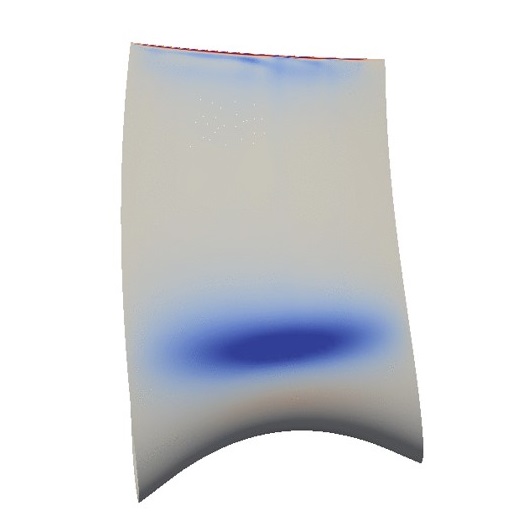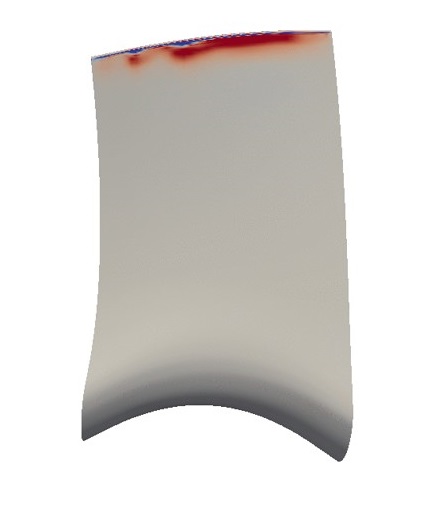Research Fellows
Georgios Ntanakas
Early Stage Researcher at RR

I was born and raised in Sparta, in the South of Greece. After high school, I moved to Athens to study Mechanical Engineering in the National Technical University of Athens (NTUA). During my studies, I took courses on (Computational) Fluid Dynamics and completed my Diploma thesis on CFD programming on GPUs. Afterwards, I completed my military service.
Currently, I am one of the ESRs of the Aboutflow project. My position is in Rolls-Royce De. (Berlin) and my academic institute is NTUA. My research is focused on applying the Discrete Adjoint Method on unsteady turbomachinery applications using Automatic Differentiation tools and developing techniques to make the method feasible to real scale industrial cases.
I see the Aboutflow ITN project as a great opportunity to personally evolve both as an engineer and a person. I believe that the possibility of living abroad, meeting and working with people from all over the world, traveling, participating in scientific workshops and conferences, having a close contact with industry will lay the foundation and prepare me for my future steps.
Objectives:
• Implementation of a one-shot method for steady design using hydra and the
RR design tools
• Application of unsteady AD to realistic unsteady turbo-machinery design cases
• extension of turbine test-case to large number of design variables
Contribute to Work Packages
Gradient-based optimization is well established in the field of shape optimization in Computational
Fluid Dynamics (CFD). To compute gradients of a specific objective functional with respect to the design variables, the adjoint method is preferred instead of forward differentiation methods. This is due to the fact that its computational cost is comparable to that of a flow solution, almost independent of the number of
the design variables and only dependent on the number of objective functions, which in CFD applications are significantly less. On the other hand, forward differentiation is dependent on the number of design variables, which in real life problems can be that many that computing gradients in this way is prohibitive.
Adjoint methods can be subdivided into continuous and discrete variants. In the continuous approach, the formulation of the adjoint equations is done prior to the discretization of the governing equations. In the discrete approach, the opposite order is followed. The governing equations are first discretized before formulating the adjoint equations.


Snapshots of unsteady sensitivity maps of pressure and suction side of a nozzle guide vane of a high pressure turbine.
Until lately, the time-independent (steady) adjoint method has been the focus of attention for obtaining gradients. But unlike fixed-wing aircraft or automotive applications, there are CFD problems which feature strongly unsteady flows such as helicopter rotors, turbomachinery blades and fluttering wings. Until recently, unsteady solutions were considered to be too expensive for the available computing power. However, the combination of the aforementioned needs with the recent advances in High Performance Computing brought time-dependent (unsteady) adjoint development into focus.
The unsteady adjoint method provides a clearer perception of the unsteady phenomena and lays the foundation for new concepts in aerodynamic shape optimization. Especially, in the field of turbomachinery steady optimisation is reaching its limits. In order to move one step further, unsteady adjoint that will lead to unsteady optimisation is needed.
References:
1. Giles, M. Pierce, N. An introduction to the adjoint approach to design. Flow Turbulence and Combustion. 65 (3) (2000): 393-415.
2. Jameson, A. Aerodynamic shape optimization using the adjoint method. VKI Lecture Series on Aerodynamic Drag Prediction and Reduction. von Karman Institute of Fluid Dynamics, Rhode St Genese, Belgium.
3. Mavriplis, D. Discrete adjoint-based approach for optimization problems on three-dimensional unstructured meshes. AIAA journal 45.4 (2007): 741-750.
4. Giannakoglou, K.C. Papadimitriou, D.I. Papoutsis-Kiachagias, E.M. The Continuous Adjoint Method: Theory and Industrial Applications. von Karman Institute Lectures Series on Introduction to Optimization and Multidisciplinary Design in Aeronautics and Turbomachinery. May 7-11, 2012.


My outreach activity idea is about an interactive presentation (including games/experiments) to primary school children.
The activity took place on March 31, 2015 at the primary school “Hourdaki” in Athens, Greece. It was held twice, for the last two grades of primary school (10 and 11 year old children).
Description: The presentation starts with examples where the air applies forces to different objects and the concepts of air velocity and pressure are explained. The children participate through simple balloon experiments in order to generate conclusions about the connection of air (and fluids) properties. A discussion follows up concerning why and how a wing produces lift, how an aircraft takes advantage of it and the concepts of propulsion and drag are introduced. The connection with the airfoils of cars is explored. After explaining the importance of aerodynamics and the need for research on that field, some videos with experiments (wind tunnels etc.) are shown. The affordability of experiments is investigated and simulations are introduced as an alternative. The children suggest which are the pros and cons of both approaches. Lastly, the need for funded research on the CFD field is discussed and EU ITNs (and AboutFlow specifically) are acknowledged by the speaker.
The purpose of the activity is to engage children with aerodynamics and then seek for the broad connection between mathematics, physics and the world we live in. The key idea is to explain why humanity needs to invest into understanding the different fields of science and try to implement all the findings into evolving technology. In order to achieve this, research is the only way to go.
The feedback received from the pupils is very positive. Most of them were interested on the subject and were willing to discuss about it or participate in the games/experiments. Pictures and mostly videos were a great tool to keep them active and the fact that conclusions were not extracted through a narrative presentation but through participation kept a smooth flow during the activity. As expected, boys were more interested on cars but I made sure that girls were also engaged by focusing on experiences, for example travelling by aeroplane or carefully placing your hand outside of a moving car in order to feel the drag. Thus, I avoided the gender-biased nature of the subject. They were less interested on the physics and more to the results of aerodynamics that they had experienced. So, I tried to include most of their experiences during the description of the physical phenomena, using examples, in order to keep the connection between the presentation and what they see in their everyday life as clear as possible. It is rather unexpected that some of them were willing to spend their break in order to keep the discussion going. Last but not least, I was surprised several times by the quality of some questions or the level of knowledge in such a technical field.
Acknowledgements: Special thanks to the director Maria Samoli for embracing my idea and offering the valuable time and equipment of the school and the parallel support teacher Zoe Pavlou for making the first contacts and arranging all the details.








